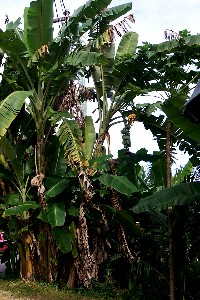
- Genus species: Musa spp
- Family: Musaceae
- English name:
- Chuukese name:
- Kosrean name:
- Pohnpeian name:
- Mwokilese name: Kaimana
- Yapese name:
- Growth form: tree
- Growth location: terrestrial
- Growth environment: cultivated garden
- Growth zone: tropical
- Average height: 4.0-9.5m
- Stem: non-woody, smooth, made from the tightly rolled leaf bases
- Leaf arrangement: whorled, simple
- Stipule:
- Petioles: .5m
- Leaf blade: Oblong, margin is entire, refuse tip, slightly shiny surface, parallel
venation, light green 3.0-3.5m
- Infloresence: complex spike
- Floral bracts: ovate, reddish
- Flower: many clusters arranged spirally in two rows, do not encircle peduncle, lower
basal 5-15 basal nodes produce female flowers, clusters of sterile flowers follows the
lower basals, the upper or distal nodes produce male flowers(S.L. Kochar, Tropical Crops)
- Calyx: fused
- Corolla:undetermined
- Stamens: five on the male flowers which produce unfunctional pollen
- Ovary: inferior
- Pistil:
- Fruit: berry, endocarp fleshy, simple fruit, yellow when ripe green when not ripe
- Seed: none observed, reminants of ovule appear as brown specks in the center of the
fruit
- Anything else: most imported and most widely grown tropical fruit. One of the oldest
known fruit to mankind
- Cultural usage: Leaf is used for wrapping food and for Uhmw. Trunk of the banana is used
for various medicinal purposes.

